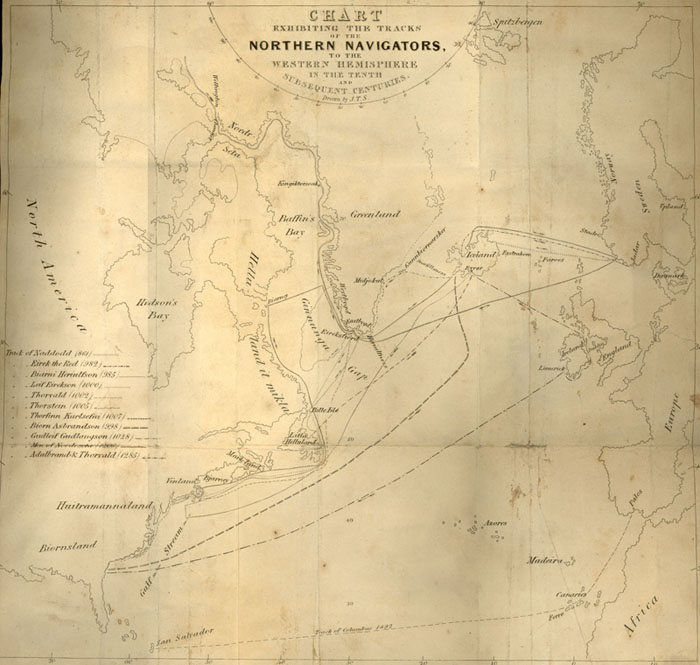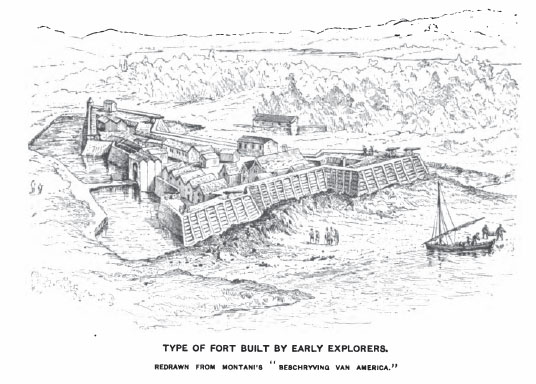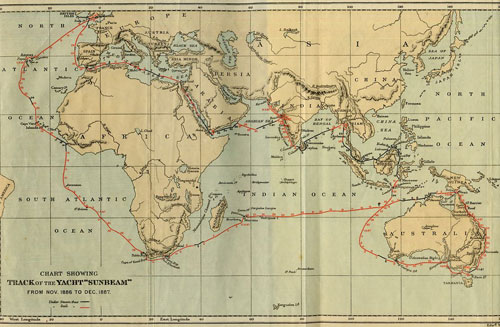By Janice Schulz
Among the strengths in our Rare Books collection is our diverse assortment of travel writings ranging from the reports of explorers to stories of leisure travel. Travel writings can offer unique perspectives to historical research about a region, providing accounts of outsiders without local views, agendas, and prejudices. They can also be valuable for comparative histories, showing change over time and varying cultural viewpoints. Among the many research areas that travel writings can support are social, ethnographic, geological, botanical, and architectural issues.
Exploration and Discovery
American school children cannot get through their education without learning about the adventures of Amerigo Vespuci, Christopher Columbus, and a band of other explorers who have been credited with the discovery of this country. But there is a lot more to exploration and discovery than what our textbooks told us. Did you know that in Welsh folklore it is believed that a prince named Madog landed in America more than 300 years before Columbus? You can read about it in An enquiry into the truth of the tradition, concerning the discovery of America by Prince Madog ab Owen Gwynedd, about the year 1170, written by John Williams in 1791, or in his follow-up publication Farther observations on the discovery of America by Prince Madog ab Owen Gwynedd, about the year, 1170, written the next year. Better known than Madog’s expedition is an even earlier claim to the discovery of America by the Norse, who say that they discovered “Vinland” or present day Newfoundland around the year 1000. Icelandic historian Thormod Torfason tells of this in his book The history of ancient Vinland, first written in Latin in 1751 and translated into English in 1891. Leif, son of Eric the Red, heard stories from a fellow named Bjarne Herjulfson, who got lost on a voyage trying to find Greenland and passed by some previously unknown lands. Leif couldn’t let this sit and decided to go off exploring on his own, eventually landing on an island resplendent with grapes and vines – thus the name with which he christened the new land, Vinland.
For a more conventional look at the discovery of America, page through Washington Irving’s three-volume Life and voyages of Christopher Columbus: to which are added to those of his companions. Irving covers Columbus’s birth, early life, and his voyages to the new world as well as the journeys of Vespuci, Balboa, Ponce de Leon, and many other explorers.
The Archives and Rare Books Library also has books about exploration and discovery in other parts of the world. Thomas Jefferson Jacobs’s 1844 book Scenes, incidents, and adventures in the Pacific Ocean, or the islands of the Australasian seas, during the cruise of the clipper Margaret Oakley, under Capt. Benjamin Morrell tells the mysterious story of the American brig Margaret Oakley’s last voyage in 1837. Neither the ship nor her leader, Captain Benjamin Morrell, ever returned. After being shipwrecked at Madagascar, the Margaret Oakley was destroyed and Captain Morrell just went a bit mad. Jacobs was a passenger on the Margaret Oakley until very fortunate circumstances separated him from the crew in Singapore.
The Journeys of Lady Brassey
The wife of Sir Thomas Brassey, an English Member of Parliament and heir to a wealthy industrialist, Lady (Annie) Brassey was also a world traveler and writer who published four books based on the travel journals she kept while aboard the family’s luxury yacht Sunbeam between 1876 and 1886. Their first voyage was literally a trip around the world, beginning in July 1876 and concluding eleven months later, after having visited the coasts of South America, the South Pacific Islands, Hawaii, Japan, Singapore, and Ceylon (modern day Sri Lanka).
Each book is full of illustrations, maps, and charts. Their titles are A voyage in the ‘Sunbeam’; our home on the ocean for eleven months (1878), Sunshine and storm in the East: or Cruises to Cyprus and Constantinople (1880), In the trades, the tropics, & the roaring forties (1885), and The last voyage (posthumously in 1889). Destinations are vast and in addition to those mentioned in the first trip include the Mediterranean Sea region, Madeira, the Caribbean Sea region, India, and Australia.
Lady Brassey’s writings began as personal observations in a journal and were never intended for publication. However, at the urging of her husband, she made her first book pubic and began on her unexpected path as a writer. The popularity of that first book was immense and afterwards her books were all greatly anticipated. Lady Brassey died from complications of malaria on board the Sunbeam on September 14, 1887 and was buried at sea off the coast of Australia.
Eclectic Volumes
You really never know what you are going to find in the collections of the Archives and Rare Books Library. Our travel volumes represent journeys from all over the world on land and sea and from the air. Authors range from well-known personalities such as Mark Twain, William Makepeace Thackeray, and Edmund Burke to private individuals sharing their personal experiences. We have books written by both men and women with varied purposes for travel. Several languages are represented in our collection, including English, German, French, Italian, Dutch, and Latin.
A selected bibliography on our travel writings has been prepared, but many more books are available through the UC Libraries catalog. For further information on the Archives & Rare Books Library and its holdings, please call 513.556.1959, email archives@ucmail.uc.edu, or visit our website.




